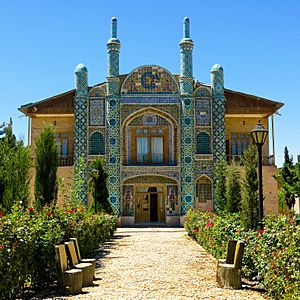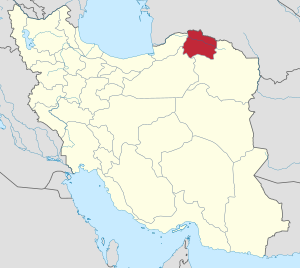North Khorasan province facts for kids
Quick facts for kids
North Khorasan Province
استان خراسان شمالی
|
|
|---|---|
 |
|

Location of North Khorasan province in Iran
|
|
| Country | Iran |
| Region | Region 5 |
| Capital | Bojnord |
| Counties | 8 |
| Area | |
| • Total | 28,434 km2 (10,978 sq mi) |
| Population
(2016)
|
|
| • Total | 863,092 |
| • Density | 30.3542/km2 (78.6171/sq mi) |
| Time zone | UTC+03:30 (IRST) |
| Main languages | Persian Kurdish Turkmen Khorasani Turkic |
| HDI (2017) | 0.745 high · 29th |
North Khorasan Province (Persian: استان خراسان شمالی, Ostān-e Khorāsān-e Shomālī) is one of the 31 provinces in Iran. It is located in the northeastern part of the country. The main city and capital of the province is Bojnord.
North Khorasan is one of three provinces created in 2004. Before that, it was part of a much larger province called Khorasan. Khorasan was the biggest province in Iran until it was divided. The Iranian parliament approved this division on May 18, 2004. The new provinces were Razavi Khorasan, North Khorasan, and South Khorasan.
In 2006, about 791,930 people lived in North Khorasan. By 2011, the population grew to about 867,727 people. In 2014, the province became part of Region 5 in Iran. The most recent count in 2016 showed the population was around 863,092 people.
Contents
A Look Back in Time
Greater Khorasan, the larger region that includes North Khorasan, has a very long and exciting history. Many different groups of people have lived and ruled here over thousands of years. These groups include Persians, Arabs, Turks, Kurds, Mongols, Turkmens, and Afghans. Each group brought changes to the area.
Ancient Iranian geographers, who studied maps and lands, divided Iran into eight main parts. The largest of these was the territory of Greater Khorasan. Cities like Esfarayen in North Khorasan were important places where early Aryan tribes settled when they first came to Iran.
Ancient Empires
The Parthian Empire, a powerful ancient kingdom, was based near a city called Merv in Khorasan for many years. During the Parthian times, Esfarayen was a key village near the famous city of Nishapur.
Later, during the Sassanid dynasty, which was another strong Persian empire, the province was managed by a military leader called a "Padgoosban." There were also four other leaders, each in charge of a different part of the province.
Islamic Era and New Rulers
In the year 651, an army of Islamic Arabs came into Khorasan. The region was then ruled by the Abbasid family until 820. After them, Iranian families like the Taherids (in 896) and the Samanid dynasty (in 900) took control. During the Muslim conquest of Persia, Khorasan was divided into four sections, each named after its biggest city: Nishapur, Merv, Herat, and Balkh.
In 994, Mahmud of Ghazni conquered Khorasan. Then, in 1037, Tuğrul Beg, the first ruler of the Seljuq empire, took over Nishapur. Mahmud Qaznavi tried to fight back several times, but eventually, the Seljuq Turks defeated Sultan Sanjar.
More changes came in 1157 when the Khwarazmids conquered Khorasan. In 1220, the region was taken over by the Mongols led by Genghis Khan. After Genghis Khan passed away in 1226, his son Tolui and then his grandson Hulegu inherited Khorasan. Hulegu became the first emperor of the Mongolic Ilkhanate in Persia.
Later Centuries
In the 14th century, a group called the Sarbedaran movement started a fight for independence in Sabzevar. By 1368, Khorasan came under the rule of Tamerlane, a famous conqueror.
In 1507, Uzbek tribes from Central Asia occupied Khorasan. After the death of Nader Shah in 1747, the Afghans took control.
In 1824, the city of Herat became independent for a few years. Persia tried to take the city in 1837, but the British helped the Afghans defend it. In 1856, Persia tried again and briefly recaptured Herat. This led to a war between Persia and Britain called the Anglo-Persian War. The war ended in 1857 with the Treaty of Paris, and Persian troops left Herat. Afghanistan then took Herat back in 1863 under Dost Muhammad Khan.
How the Province is Organized
North Khorasan Province is divided into several smaller areas called counties. Each county has its own population. Here's a look at how the population of these counties has changed over time:
| Administrative Divisions | 2006 | 2011 | 2016 |
|---|---|---|---|
| Bojnord County | 322,309 | 365,896 | 324,083 |
| Esfarayen County | 119,152 | 127,012 | 120,513 |
| Faruj County | 48,743 | 52,364 | 49,271 |
| Garmeh County1 | — | 24,599 | 25,475 |
| Jajarm County | 57,349 | 36,898 | 36,673 |
| Maneh and Samalqan County | 91,884 | 103,944 | 101,727 |
| Raz and Jargalan County2 | — | — | 59,210 |
| Shirvan County | 152,493 | 157,014 | 146,140 |
| Total | 791,930 | 867,727 | 863,092 |
| 1Separated from Jajarm County 2Separated from Bojnord County |
|||
Main Cities
Many people in North Khorasan Province live in cities. In 2016, over 56% of the province's population, which was about 484,346 people, lived in cities. The largest city is Bojnord, with 228,931 residents. Other important cities include Shirvan (82,689 people) and Esfarayen (59,490 people).
Life in North Khorasan Today
North Khorasan is a very diverse place, meaning many different groups of people live there. This reflects the mix of cultures found across Iran. Most people in North Khorasan are Shia Muslims. These include Khorasani Kurds, Persians, and Khorasani Turks. There is also a smaller group of Sunni Muslims, who are generally Turkmen.
Long ago, there were many Arabs who settled in the area after the Arab invasion of Iran. However, by the late 1800s, they had mixed so much with Persians and Turks that they were hard to tell apart. They had mostly stopped speaking Arabic and adopted the local languages and customs.
Culture and Fun Things to See
North Khorasan has many interesting historical places and beautiful natural spots. You can find mineral water springs, small lakes, and places to relax outdoors. There are also caves to explore and many areas perfect for hiking. Most of the historical buildings you see today are from the Qajar era. This is because earthquakes have sadly damaged many older buildings over time.
The Cultural Heritage Organization of Iran has listed 1,179 important historical and cultural sites across all three Khorasan provinces.
Some of the popular places to visit in North Khorasan include:
- Besh Qardash (meaning "five brothers") and Baba-Aman springs, which are natural water sources.
- The Jameh Mosque of Jajarm, an old and beautiful mosque.
Colleges and Universities
North Khorasan is also home to several places where students can go for higher education:
- University of Bojnurd
- Islamic Azad University of Bojnurd
- Eshragh Institute of Higher Education (Bojnurd, North Khorasan)
- Islamic Azad University of Shiravan
- Hakiman Institute of Higher Education (Bojnord, North Khorasan)
- North Khorasan University of Medical Science (Bojnord, North Khorasan)
Images for kids
See also
 In Spanish: Provincia de Jorasán del Norte para niños
In Spanish: Provincia de Jorasán del Norte para niños










